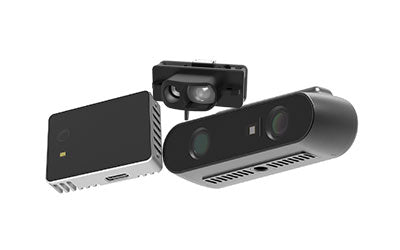Hindernisvermeidung durch Drohnen in Innenräumen und die Rolle von ToF-Sensoren

Verbesserte Objektvermeidung durch Drohnen mit Time-of-Flight-Technologie
Die Time-of-Flight-Technologie ( ToF ) verbessert die Hindernis- und Kollisionsvermeidungssysteme von Indoor-Drohnen. Dank präziser Tiefenmessung ermöglichen ToF -Sensoren die Hinderniserkennung in Echtzeit und verbessern so die Flugsteuerung . Dadurch können Drohnen ihre Flugrouten automatisch anpassen, um Kollisionen mit Hindernissen wie Möbeln oder Wänden zu vermeiden.
Die Integration mit Fernbedienungen ermöglicht eine nahtlose Steuerung, während die Vermeidungstechnologie für Sicherheit sorgt. Mit fortschreitender Drohnentechnologie werden diese Systeme noch intelligentere und autonomere Flugfunktionen bieten und so die Sicherheit und Effizienz in verschiedenen Anwendungen verbessern.
Mit der Weiterentwicklung der Drohnentechnologie sind Indoor-Drohnen zu unverzichtbaren Werkzeugen in vielen Anwendungsbereichen geworden. Im Gegensatz zu Außenbereichen sind Innenräume mit verschiedenen komplexen Hindernissen wie Möbeln, Wänden und Kabeln behaftet. Um einen sicheren Flug und einen effizienten Betrieb von Indoor-Drohnen zu gewährleisten, spielt die Time-of-Flight-Technologie (ToF) eine entscheidende Rolle. Durch hochpräzise Tiefenmessung und Hinderniserkennung verbessert die ToF-Technologie die Hindernisvermeidungsfähigkeit und die Intelligenz von Drohnen erheblich.
Anwendung der ToF-Technologie in Indoor-Drohnen
-
Präzise Hinderniserkennung
Die ToF-Technologie misst die Zeit, die ein Lichtimpuls vom Sensor zum reflektierenden Objekt und zurück benötigt, und liefert so präzise Entfernungsinformationen. Bei Indoor-Drohnen können ToF-Sensoren Entfernungen zu Hindernissen in komplexen Innenräumen in Echtzeit erkennen und messen. Diese hochpräzise Erkennung ermöglicht es Drohnen, potenzielle Hindernisse während des Fluges schnell zu identifizieren und so Kollisionen effektiv zu vermeiden.
-
Dynamische Hindernisvermeidung
Die dynamische Natur von Hindernissen in Innenräumen (wie sich bewegende Haustiere oder Personen) erschwert die Hindernisvermeidung. Die ToF-Technologie unterstützt hochfrequente Datenaktualisierungen, sodass Drohnen diese dynamischen Hindernisse in Echtzeit verfolgen können. Erkennt eine Drohne Veränderungen an Hindernissen, kann sie ihre Flugroute schnell anpassen, um Kollisionen zu vermeiden und so einen sicheren Flug zu gewährleisten.
-
Intelligente Pfadplanung
Mithilfe detaillierter Tiefendaten der ToF-Technologie können Drohnen eine intelligente Flugroute planen. Nach Erkennung eines Hindernisses kann die Drohne automatisch die optimale Route um das Hindernis herum planen. Diese intelligente Flugroute verbessert nicht nur die Flugeffizienz, sondern reduziert auch manuelle Eingriffe und ermöglicht so einen autonomeren Flugbetrieb.
Ergänzende Nutzung mit anderen Sensortechnologien
-
Integration mit visuellen Sensoren
Die ToF-Technologie kann durch visuelle Sensoren (wie Stereovisionssysteme) ergänzt werden. Während ToF-Sensoren präzise Tiefeninformationen liefern, erfassen visuelle Sensoren detaillierte Bilder der Umgebung. Diese Kombination verbessert die Genauigkeit der Hinderniserkennung und ermöglicht es Drohnen, Hindernissen auch bei schlechten Lichtverhältnissen oder in komplexen Umgebungen effektiv auszuweichen.
-
Zusammenarbeit mit Ultraschalltechnologie
Ultraschallsensoren werden auch häufig zur Entfernungsmessung eingesetzt. Die Kombination von ToF-Technologie mit Ultraschallsensoren ermöglicht eine mehrschichtige Hinderniserkennung über unterschiedliche Entfernungsbereiche und Umgebungsbedingungen hinweg. Dieser kollaborative Ansatz verbessert die Hindernisvermeidungsfähigkeit von Drohnen, insbesondere in komplexen und dynamischen Innenräumen.
Zukunftsaussichten
-
Zunehmende Miniaturisierung und Integration
In Zukunft wird die ToF-Technologie weiter miniaturisiert und integriert, um den Größen- und Gewichtsanforderungen von Indoor-Drohnen gerecht zu werden. Durch den Einsatz leistungsstarker ToF-Sensoren können Drohnen leistungsfähigere Hindernisvermeidungsfunktionen in kleinerem Volumen realisieren und so ihre Einsatzmöglichkeiten in Innenräumen erweitern.
-
Verbesserte Anpassungsfähigkeit an die Umwelt
Mit der Weiterentwicklung der ToF-Technologie können Drohnen Hindernissen in vielfältigeren Innenräumen effizient ausweichen. Verbesserte ToF-Sensoren gewährleisten eine stabile Leistung unter verschiedenen komplexen Bedingungen wie schwachem Licht, starkem Licht oder reflektierenden Materialien und verbessern so die Einsatzfähigkeit und Sicherheit von Drohnen weiter.
-
Erweiterung intelligenter Funktionen
Drohnen mit ToF-Technologie können automatisiertere und intelligentere Funktionen realisieren, darunter autonomes Laden, automatische Rückkehr und Aufgabenplanung. Diese intelligenten Funktionen machen Indoor-Drohnen vielseitiger einsetzbar und kommen in verschiedenen Bereichen von der Heimautomatisierung bis zur industriellen Inspektion zugute.
Zukünftige Anwendungen von Indoor-Drohnen
Mit der kontinuierlichen Weiterentwicklung der Time-of-Flight-Technologie (ToF) und der Drohnentechnologie werden die Anwendungsszenarien für Indoor-Drohnen immer vielfältiger und umfangreicher. Zukünftig werden diese Drohnen in mehr Bereichen eine wichtige Rolle spielen und ein höheres Maß an Intelligenz und Automatisierung ermöglichen.
-
Smart Home-Verwaltung
Indoor-Drohnen werden in Smart-Home-Systemen eine immer wichtigere Rolle spielen. Zukünftig könnten Drohnen automatisch durch das Haus patrouillieren und verschiedene Bereiche überwachen, beispielsweise den Gerätestatus und die Sicherheit im Haus prüfen oder schwer zugängliche Stellen reinigen. Darüber hinaus könnten Drohnen in Smart-Home-Systeme integriert werden, um automatisierte Aufgaben wie die Lieferung von Artikeln oder die Einstellung von Haushaltsgeräten zu übernehmen und so den Wohnkomfort zu steigern.
-
Industrielle Inspektion und Wartung
In industriellen Umgebungen werden Indoor-Drohnen zur automatisierten Anlageninspektion und -wartung eingesetzt. Beispielsweise können Drohnen den Anlagenzustand in Werkstätten überwachen, potenzielle Fehler oder Anomalien erkennen und Echtzeit-Feedback liefern. Diese Anwendung trägt dazu bei, die Kosten und Risiken manueller Inspektionen zu reduzieren und so die Sicherheit und Effizienz in der industriellen Produktion zu verbessern.
-
Lager und Logistik
In großen Lagern und Logistikzentren können Indoor-Drohnen für automatisiertes Frachtmanagement und Transport eingesetzt werden. Drohnen können autonom in Lagern navigieren, Bestandsprüfungen durchführen, Fracht abfertigen und die Auslieferung erleichtern. Dies verbessert nicht nur die Lagereffizienz, sondern reduziert auch menschliche Fehler und erhöht die Genauigkeit und Geschwindigkeit der Logistikabläufe.
-
Medizinische Versorgung und Notfallmaßnahmen
Auch im medizinischen Bereich und bei der Notfallversorgung bieten Indoor-Drohnen großes Potenzial. So können Drohnen beispielsweise Medikamente und medizinische Geräte innerhalb von Krankenhäusern transportieren und so den manuellen Zeitaufwand und die Arbeitskosten reduzieren. Im Notfall können Drohnen schnell in Gefahrenbereiche vordringen, erste Einschätzungen vornehmen und Einsatzkräfte bei der effizienteren Durchführung von Rettungseinsätzen unterstützen.
-
Intelligente Sicherheit
Zukünftige Indoor-Drohnen werden fortschrittlichere Sicherheitsfunktionen wie Echtzeit-Videoüberwachung, Einbruchmeldeanlagen und Alarmsysteme integrieren. Drohnen können automatisch in Häusern und Büros patrouillieren, verdächtige Aktivitäten erkennen und Echtzeitberichte erstellen, was die Sicherheit von Häusern und Unternehmen erhöht.
Durch die kontinuierliche Optimierung der ToF-Technologie und Innovationen in der Drohnentechnologie werden die zukünftigen Einsatzmöglichkeiten von Indoor-Drohnen intelligenter und vielfältiger. Diese Entwicklungen ermöglichen es Drohnen, in verschiedenen Bereichen eine wichtigere Rolle zu spielen und Smart Home, industrielle Automatisierung, Logistikmanagement und vieles mehr voranzutreiben. Sie bringen mehr Komfort und Vorteile in unser Leben und unsere Arbeit.
Synexens 3D RGBD ToF Tiefensensor_CS30
Synexens 3D-Kamera des ToF-Sensors Soild-State Lidar_CS20
Kundendienst:
Unser professionelles technisches Team, spezialisiert auf 3D-Kamera-Entfernungsmessung, steht Ihnen jederzeit zur Verfügung. Egal, ob Sie nach dem Kauf Probleme mit Ihrer TOF-Kamera haben oder Fragen zur TOF-Technologie haben, kontaktieren Sie uns jederzeit. Wir legen Wert auf hochwertigen technischen Kundendienst und ein optimales Benutzererlebnis, damit Sie unsere Produkte unbesorgt kaufen und nutzen können.
-
Publié dans
CS20






